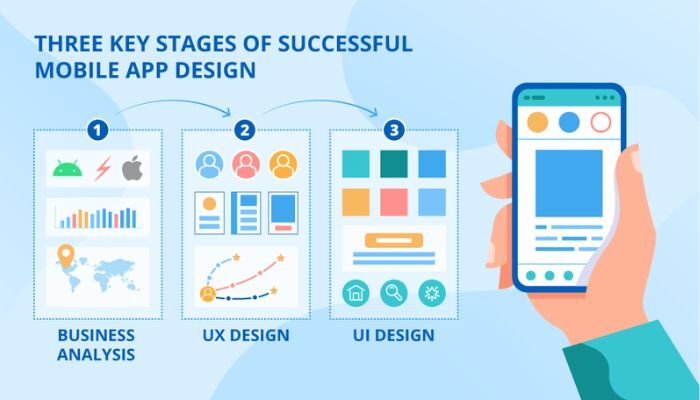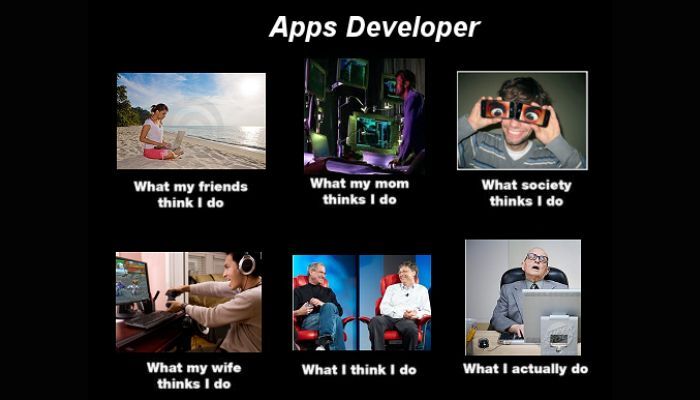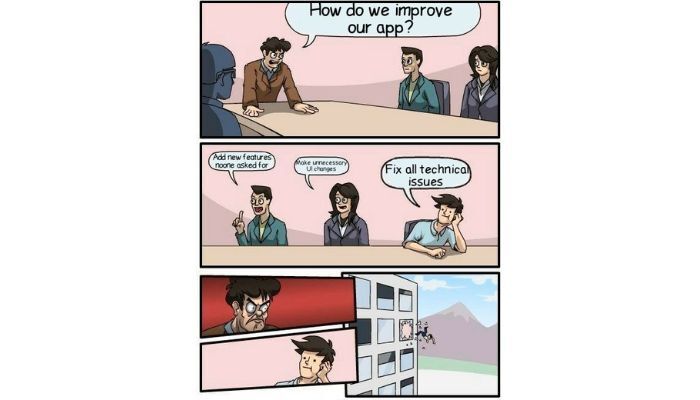
To ensure that your mobile app concept is successful it’s important to have a clear understanding of the purpose and target audience for the project.
Consider what problem your app want to address, who will be accessing it most often, and how you can segment users so that you understand their needs better.
Research current competitors in the niche as well as emerging technology trends in order to ensure maximum potential for success.
Then create loyal user personas for which your product can seamlessly fit into lifestyle or day-to-day activities over time. With each additional step taken during this process—including verifying technical feasibility—you’ll become one crucial step closer to realizing your idea!
Conducting market research is invaluable when developing your own app. Researching competitors, user trends, and technology are crucial in identifying an understanding of a target user base. You will then know better which features may be beneficial for users as well as what limits you have to work within based on popular expectations.
Being aware of existing market needs can alert team members to problems that need solving, opportunities best pursued as well as uncover experiences you either won’t want to recreate or can draw from for more successful solutions. Understanding your competition is important too so that further innovation can be executed before the full launch.
Setting clearly defined goals and objectives is essential for success in any mobile app development project. By defining certain “must-have” features, you can eliminate any confusion about the purpose of the app.
Your objectives should map out how users achieve those results — for instance, cutting down on the number of clicks, offering intuitive navigation paths etc.
This could lead to vigorous user engagement and validate your time and budget investments in developing this product/service idea into a viable app concept. Users are more likely to adopt an app if it meets their needs effectively by providing useful solutions which can satisfy their emotions as well as serving their utilitarian purposes.

User Experience Design (UX) is an important step in getting ready for mobile app development, as it ensures the best possible user experience when using the app.
When sketching app wireframes and creating prototypes, one must keep in mind setting physical boundaries of their designs that would be later tested against each other according to features they can provide or satisfaction degrees of same element usage.
Usability and livability should also be a top priority when designing the UX since users are more likely to stick with products or services which gives them easy access from logging system fields to core data entering parts of your mobile apps.
When it comes to user experience design, planning the app’s navigation and flow is key for a great user experience. This includes organizing all of the features, screens, functionalities, interactions, and experiences into a logical path that users will find easy to understand.
When crafting the user journey through your app keep in mind documentation like personas, flowcharts or storyboards that might help you better understand how elements should be connected so your users can transition between them with minimal effort.
Make sure to test this before launching to ensure natural interactions for actual users when they start using the app.
The core focus of User Experience Design (UX) is to design for the optimum user experience so that users can properly engage and utilize an app.
Incorporating feedback from real-world users helps validate the assumptions that went into the design process – it effectively tests whether those things are working as expected and allows app developers to concisely identify where additional improvements or features need to be implemented.
Iterative design processes also help ensure a cohesive approach; developing parts throughout while iteratively improving and refining closer to launch, in response to batch testing cycles and user feedback for further optimization.

When beginning the mobile app development process, it is important to evaluate which platforms (iOS, Android, or both) you plan on targeting for your final product.
Understanding platform usage trends, determining hardware requirements which need to be factored into User Experience designs and budgeting appropriately should all be taken into consideration.
Some considerations are more technical such as divergence in system architecture split between iOS and Android native applications calling upon different language scripts and databases making portability an issue across certain third-party program frameworks.
Choosing the right mobile platform will also impact development and QA efforts with dedicated teams to manage software releases.
When developing a mobile app, technical considerations play an important role. Selecting the right development frameworks and tools can significantly influence the stability, scalability and overall success of your product.
Many popular development platforms come with built-in features or support third-party integrations that simplify routine tasks and streamline multiple aspects of the development process.
It’s also vital to choose platforms that provide sufficient platform support for everything from hardware capabilities to multimedia content. End-users expect an intuitive application experience free from hiccups so making sure you select efficient technologies is key!
When planning out the technical specifications of a mobile app, it’s important to assess the best backend infrastructure and data storage options.
This means finding solutions that will ensure performance, scalability, reliability, good user experience across multiple mobile devices, and secure data protection and privacy requirements.
Factors like budget constraints, platform support for various features (billing systems or push notifications), and development teams’ expertise in certain technologies including programming languages like Java or Swift are all needed factors to determine when deciding on matching backend solutions.
Developing an app requires careful planning and multiple steps carried out in the right order. Breaking down the entire development process into milestones is essential for successful app completion.
Milestones need to be arranged with a clear timeline for each one. This includes not only choosing what tasks need to be performed during each milestone but also allocating adequate time frames for completing them correctly, as this will ultimately have heard on whether the app meets user expectations.
Developing mock-ups, coding, testing and user feedback are just some of the many activities that should be taken into consideration within your planned timeline before arriving at final completion.
When planning the development timeline for a mobile app project, accuracy is key. Estimating timeframes will help provide an indication of when certain milestones in the project will be completed, allowing for more precise scheduling and improved resource allocation.
The timeline estimated should factor in any unforeseen complications that may arise during the development process to ensure tasks are allocated with appropriate blocking of other related activities which might affect its delivery date.
Additionally, flexibility as part of the schedule should be allowed considering limitations such as coordination among team members or adjusting the scope of deliverables to accommodate competing priorities and last minute surprises beyond anyone’s control.
Creating a development timeline is an important step for properly preparing for mobile app development. Timeframes should be estimated accurately to ensure that everything is on track and that the project can be completed in the desired timeframe.
However, due to various unexpected factors, there will likely be delays or changes in the planned course of action. This should all be accommodated by allowing flexibility into the timeline to prevent any stress associated with having too many tasks crammed up simultaneously.

The task of assembling a development team organized around the app’s scope, features, functionalities, and platform may seem daunting. It is important to carefully identify the specific roles each developer brings to the project as well as the necessary skill sets needed through inception to deployment and maintenance.
This could include mobile engineering (iOS/Android), back-end engineering (network stack) user experience design & UI/UX Designers, and even DevOps & cloud infrastructure specialists.
Additionally, there are several alternative platforms like out which could provide additional resources such as Shortlist for hiring freelance developers or Launchpad Lab which develops bespoke applications end-to-end.
Outsourcing a software developer or development team can be a great way to lighten your workload and gain more expertise for tackling complex projects. When hiring, look for developers with plenty of experience and technical expertise in building mobile apps suitable to your industry.
Ensure they are well equipped with the latest tools, coding languages, and technologies necessary to design robust applications. Consider open-sourced freelance platforms as these can help you scout for highly talented individuals from varied locations worldwide while saving on cost.
You should weigh the pros and cons carefully between full-time, per-project hires vs remote cases like needing an app quickly and choosing an offshore outsourcing firm that has deeper specialized experts to do component dev pieces.
Flutter is a popular open-source UI software development toolkit created by Google. It is known for its ability to help developers build natively compiled applications for mobile, web, and desktop from a single codebase. When it comes to developing mobile apps for Android and iOS, Flutter offers several benefits:
In summary, Flutter’s ability to provide a single codebase, its performance, hot reload feature, and a rich set of customizable widgets make it a compelling choice for developers looking to build mobile apps for both Android and iOS platforms.
Coding is the main part of the mobile app development process, where developers create both frontend and backend components based on specific instructions. Frontend components refer primarily to the design interface and user experience. Backend, on the other hand, refers to server-side programming languages that store data and manage machine operations for desktops and smartphones alike.
The coding process requires a comprehensive yet flexible approach that accounts for desired features, scalability needs, versatility requirements, tech stack compatibility etc. Information from UX Design team is usually taken into consideration as well for smoother functionality optimization of the app.
Testing and debugging are important steps of the app development process. Testing ensures that the app is bug-free and within its expected specifications.
Debugging further isolates any problems by finding their source; code issues then must be rectified before app testing resumes.
Developers can periodically undertake manual or automated tests with a team, devising a checklist and assessing system aspects from core functionality to scaling capacity.
Use cases should also consider corner scenarios in order to determine real-world conditions will cause unexpected behavior or issues in response times.
When iterating and refining based on user feedback, revising designs should be done systematically with an understanding of data-driven decision-making.
This helps ensure that the changes made are actually reflected in how users respond to your product. Through consolidated analysis and predictions of user behavior, modifications can be implemented for a more user-centric result.
Testing can further boil down potential big risks or problems within the app’s interface from continual users participation to better performance or lower customer churn – ultimately providing inputs towards positive improvement results in usability metrics.
Preparing an app for release on app stores can be a daunting task. It’s important to create optimized icons or splash screens and upload submission questionnaires.
One should also check the accepted keywords, file sizes, copyright permissions, etc before submitting the app.
Lastly, make sure that suitable records are maintained regarding beta testers’ feedback about whether requirements have been fulfilled and whether quality objectives have been reached before uploading the final version of the application in an App Store.
App Deployment and Distribution involves readying an app for submission to its chosen platform’s application store, such as Apple’s App Store or Google Play Store.
To maximize the discoverability of the app and therefore, attract more users, it is important to implement App Store Optimization (ASO) techniques through careful keyword selection, compelling visuals such as icons and screenshots etc., descriptive titles with relevant info at a glance, and catchy yet informative description texts which should clearly highlight your app’s features & benefits.
Take the time to identify what works best in your region/niche by keeping track of competitors’ ranking keywords trends and optimizing continuously.

Effective maintenance and ongoing updates to a mobile application are imperative for strong performance in the app marketplace.
Monitoring the app’s performance and user feedback is key when it comes to ensuring proper functioning.
App developers should monitor crash logs data, find areas where the user interface (UX/UI) needs improvement, assess customer service inquiries with regular intervals so that trends among issues can be made obvious, track usage statistics, and analyze user reviews both positively or negatively in order to discover more details about an issue if one arises.
Developing an app takes thorough preparation in order to enable successful product launch and sustained user engagement.
This guide provided information on the key steps for effective planning, design, development, deployment, and maintenance of a mobile app.
Crucial skills and resources need to be acquired, a timeline needs to set, and frequent iterating based on user feedback should be encouraged throughout the whole process. With the right combination of preparation and execution, your team will undoubtedly bring your latest mobile apps creation idea to life with pride!
If you’re looking to develop your own iOS or Android apps, look no further than DEV! We are a mobile app development company that can get your next project off the ground.
VP Sales at Software Development CompanyRyan is the VP of Operations for DEV.co. He brings over a decade of experience in managing custom website and software development projects for clients small and large, managing internal and external teams on meeting and exceeding client expectations--delivering projects on-time and within budget requirements. Ryan is based in El Paso, Texas.
Connect with Ryan on Linkedin.